
St. Joseph Boys Make Every Point Count in Clinching 1st Finals Since 1997
By
Keith Dunlap
Special for MHSAA.com
June 3, 2023
ROCKFORD – Entering the final event of Saturday’s Lower Peninsula Division 1 Final, the 1,600 relay, St. Joseph was in first place – but by the slimmest of margins.
St. Joseph had 35.75 points, while Rockford had 35, Clinton Township Chippewa Valley had 32, and Ann Arbor Huron had 30.
Bears head coach Todd Rose knew his team was in the second heat before faster teams after, but his for sure needed to be faster than Rockford.
“I don’t teach them to worry about who they are running against,” Rose said. “Just run within themselves and run how we teach them.”
St. Joseph did that behind the team of Shay White, Will Fiesbeck, Eli Toney and Alex Moyer, finishing fourth in the event with a time of 3:21.50 to earn a meet-best 40.75 points – clinching the program’s first Finals team championship since 1997.
Chippewa Valley was runner-up with 38 points, while Rockford was third at 36 points.
St. Joseph senior Gerald Capaccio scored 18 precious points for his team, most notably winning the discus with a winning throw of 167-2. Capaccio said he was in second going into his last throw.
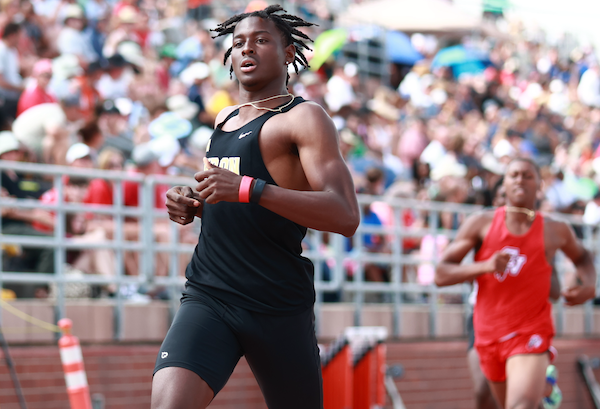 “I just had the mindset that everyone can have a big throw, and it just has to be me that gets the big throw,” Capaccio said. “It happened on my final throw.”
“I just had the mindset that everyone can have a big throw, and it just has to be me that gets the big throw,” Capaccio said. “It happened on my final throw.”
Capaccio also was second in the shot put with a throw of 56-11¼.
In addition to Capaccio earning big points in the shot put and discus, Rose gave credit to high jumper Joshua Scott for finishing in a tie for seventh in that event. That gave the Bears two points, and they proved to be especially important as the team won by less than one.
It’s rare when a runner does something that hasn’t been achieved since before automobiles were invented, but Ann Arbor Huron senior Braxton Brann had that distinction.
Brann won the 110 hurdles and the 200 dash, becoming the first athlete to win those two events at the same state meet since 1895 – three decades before the MHSAA was formed.
“It’s great to be in that kind of conversation,” said Brann, who will run in college at Ohio State.
First, Brann won the 110 hurdles in a time of 13.77. He said that was the event he was most concerned about.
“I haven’t really been consistent, so I just wanted to be that,” Brann said.
Feeling much more comfortable and at home in the 200 dash, Brann ran a winning time of 21.12.
“Everybody comes in looking at the stats of everybody else,” he said. “I saw I was in the best position to win. But I knew I had to run by butt off against this great field and come out with a win.”
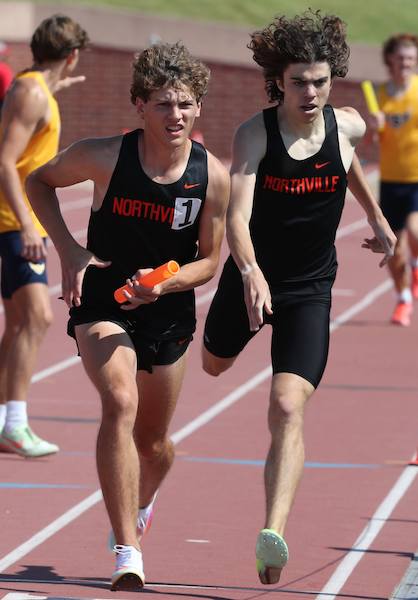 Just about everyone in the stadium did a double-take when Northville’s 3,200 relay time was posted. The team of Brandon Latta, Brock Malaikal, David Whitaker and Brendan Herger set a new all-Finals record with a blistering time of 7:35.32, which was the best time in the nation this year.
Just about everyone in the stadium did a double-take when Northville’s 3,200 relay time was posted. The team of Brandon Latta, Brock Malaikal, David Whitaker and Brendan Herger set a new all-Finals record with a blistering time of 7:35.32, which was the best time in the nation this year.
Herger said when he got the baton on the anchor leg, he knew his teammates set him up incredibly well. But even he and Northville couldn’t have foreseen this.
“I had to run 1.54 to get it, and then I ended up running a bit faster than that,” Herger said. “I was so happy. I love my boys so much. It was great to share the moment together.
Herger also ended up finishing second in the 800 meters with a time of 1:52.19 behind Utica’s Trent McFarland.
Detroit U-D Jesuit senior Jaiden Reed won the 100 (10.74), and Clinton Township Chippewa Valley junior Shamar Heard won the 400 (47.78). Grand Rapids Ottawa Hills senior Benne Anderson won the 1,600 (4:05.44), and Grand Haven junior Seth Norder won the 3,200 (9:04.68). Kalamazoo Central senior Kayenn Mabin won the 300 hurdles (38.31). Rockford in the 400 (42.01), Chippewa Valley in the 800 (1:26.41) and Oak Park in the 1,600 (3:18.90) also won relay titles.
Battle Creek Lakeview senior Andrew Berryhill was champion in the shot put (58-¼), and Saline senior Dolan Gonzales won pole vault (16-0). Ann Arbor Huron junior Andrew Harding won the high jump (6-7), and Canton sophomore Quincy Isaac won the long jump (22-11). New Baltimore Anchor Bay sophomore Luke Bowman competed in the adaptive 100 (19.65), 200 (35.66) and 400 (1:14.39).
PHOTOS (Top) St. Joseph celebrates its LPD1 championship Saturday. (Middle) Ann Arbor Huron's Braxton Brann finishes one of his two race wins. (Below) Northville makes the final exchange of its record-setting 3,200 relay. (Photos by Jamie McNinch [top two photos] and Carter Sherline/RunMichigan.com.)
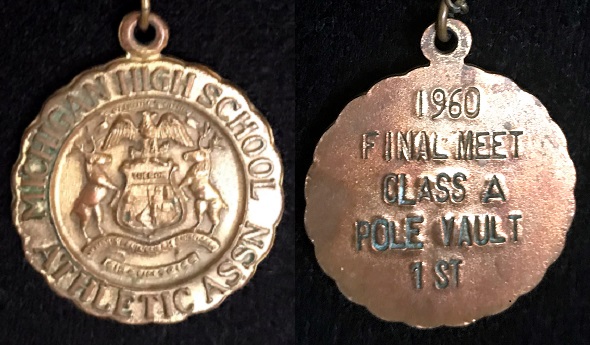
60 Years Later, Co-Champ Rediscovered
March 25, 2020
By Ron Pesch
Special for Second Half
Nicholas “Mickey” Turcheck tells a wild story. It involves a coin flip.
Involved in track & field for much of his life, Turcheck was a pole vaulter at Taylor Center during his high school days, then at Western Michigan University. He later served Taylor Center for more than three decades as track coach, where he mentored five state champions.
He also coached two future Olympians. Earl Jones, who won MHSAA Finals track titles in both 1980 and 1981, and grabbed bronze in the 800 meters at the 1984 Summer Olympics in Los Angeles. Another of his athletes, Deby LaPlante, qualified for the 1976 Summer Olympics in Montreal as a high hurdler.
In Turcheck’s possession is a medal. Etched on the back, pounded out in the style of the time, are five lines.
1960
FINAL MEET
CLASS A
POLE VAULT
1ST
Those 31 characters honor his MHSAA championship performance on what became a windy day in Ann Arbor at University of Michigan’s old Ferry Field.
But there is one problem. Turcheck’s name doesn’t appear on the MHSAA list of Finals champions. According to the list, the championship belongs to Joe Baldy of Monroe.
(The list has since been corrected and amended, per the story to be told below.)
Trackheads
For ‘trackheads’ – diehard fans of the sport and the events that comprise a track meet – as well as sports historians, a newspaper’s agate page is nirvana. Contained within the tiny type are the details that aren’t always relayed within the article covering a sporting event. Things like baseball batting averages, league standings, box scores, stat lines, team transactions, TV and radio schedules, and most everything else that doesn’t fix conveniently into the day’s sports section might appear on the page. For a track meet, a full agate listing will include place finishes as well as times, heights and distances that were used to determine winners of events, as well as detail on record performances that were equaled or topped.
Jim Moyes is a passionate sports fan. An undersized high school athlete at a small school, where participants of all shapes and sizes are valued, Moyes was the son of a prep coach at North Muskegon High School. He grew up and became, among other things, a beloved and respected broadcaster and public address announcer. Few were as well-prepared as Moyes, who studied agate pages, past performances, and, it seemed, the family trees of the participants prior to sitting before a microphone. His knowledge, as well as his sense of humor, was on display for 43 years in West Michigan, where he would balance his understanding and importance of an event with the awareness that, in the end, what we were experiencing was still just a game.
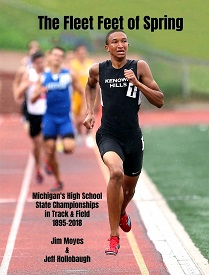 Well over 30 years ago he began his research into a passion project. Moyes is a ‘trackhead.’ And, because of this, in 2019, he officially became the author of a published book.
Well over 30 years ago he began his research into a passion project. Moyes is a ‘trackhead.’ And, because of this, in 2019, he officially became the author of a published book.
Way back, Moyes began digging into microfilm with the goal of capturing the names and events behind each MHSAA Finals track championship. He shared his initial research with the MHSAA, and for years the Association has highlighted his work on its website with lists of individual state champions on both their boys and girls track pages.
A couple of years before wrapping up his research, Moyes began work with another certified ‘trackhead,’ Jeff Hollobaugh – associated editor of Track & Field News, the voice of countless track meets, and as Moyes states, an “expert on this great sport” – to tell the stories of the meets in book form. “The Fleet Feet of Spring” – a history of Michigan’s High School State Championships covering the span 1895-2018 – was the result.
That’s 24,446 state champions. Simply put, its 439 pages contain a marvelous collection of statistics, stories and images.
But, with good reason, Turcheck’s name doesn’t appear in the publication.
Golden Age of Newspapers
Post-event press coverage on the 1960 MHSAA State Track Meet for most readers across Michigan arrived in their newspaper courtesy of coverage by wire-service reporters from The Associated Press or United Press International. With four meets to cover that encompass hundreds of prep athletes, the arch of the stories generally focus on record-setting events and streaks of success.
In Class A, the story was focused on the Pontiac Central squad that slipped past Flint Northern, 44-41, for its fifth title in six years. It was the seventh year in a row that the Vikings finished second at the meet. Pontiac junior Bredell Pritchett’s 59-foot-5¾ toss of the shot exceeded the previous state mark by better than two feet. Northern’s Maurice Pea, clocked at 9.8 seconds, tied a 35-year-old mark in the 100-yard dash. Al Ammerman of Dearborn established a new high jump record.
In 1960, the details of the pole vault simply weren’t the story.
Available space in newspapers is dictated by advertising. That certainly is the case today, and was most certainly the case back in the glory days of newsprint. Decisions are made by sports editors and staff on the amount of space available, and what agate will be printed. The results of a track meet, let alone the four simultaneous meets that comprise the MHSAA state championships, can certainly eat up plenty of real estate.
Relatively few papers around Michigan dedicated space to the MHSAA Track Championships back in May 1960. The old Detroit Times is among those that did include agate. Study of the listing however provides little clarity, as the paper listed only Metro Detroit finishers beyond the event winners. For the pole vault, that means confusion.
Pole Vault – “1 Joe Baldy, Monroe: Mickey Turcheck. Taylor Center: Bob Davis. Redford Union. and Larry Richardson. Livonia Bentley. were among those tieing for fourth. Distance 12 feet, 9 inches.”
The Grand Rapids Press agate adds haze to the mix. Baldy is listed in first, but Turcheck is listed as finishing second, followed by Flint Northern’s Jerry Wright in third. Davis, Richardson, Mike Pedler of Muskegon, J. Best from Battle Creek Central and Bill King of Traverse City are listed as occupying fourth place
The Battle Creek Enquirer lists only Baldy as the winner of the event and John Best “tied for fourth.” The Lansing State Journal agate shows only Baldy as the event winner. No track agate appears in the Detroit Free Press. Although the paper notes that team-wise, Birmingham finished third with 18 points, followed by Dearborn, Ann Arbor, Muskegon and Saginaw Arthur Hill in its coverage, the results from the Class A pole vault are not mentioned.
The Traverse City Record-Eagle does not include agate, but the article notes King’s fourth place finish, and that the Trojans track team spent the night sleeping on tumbling mats in the Saginaw Arthur Hill gymnasium when its bus broke down on the return trip home from Ann Arbor.
So, with little surprise, Moyes’ research concluded Baldy was the 1960 Class A pole vault champion.
Story of the Medal
In early March, Tony Mifsud, a longtime track coach at Dearborn Divine Child, contacted MHSAA Director of Broadcast Properties John Johnson about the story.
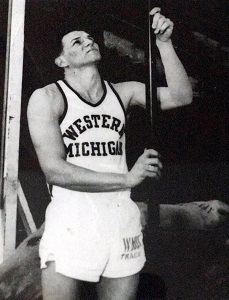
Turcheck was recently visiting a friend, Bob Parks, the head track coach at Eastern Michigan University for 34 years and an assistant track coach at Western Michigan during Turcheck’s time in Kalamazoo competing for the Broncos. On a visit this past fall, Parks mentioned the Moyes and Hollobaugh book that he had recently received.
“Mick, your name is not listed there,” said Parks. “I know you were tied for the state championship because I was the coach at Redford Thurston at that time and I was at the state meet. I remember you being announced as the co-state champion of the pole vault.”
“I said, ‘Really?’” recalled Turcheck from his home in Taylor.
After the visit, he made a couple of phone calls to friends. In turn, some of those folks began reaching out to others with the story.
According to Turcheck, after the pole vault was over, a meet official said they only had one medal and they were going to flip to determine who would receive it. Turcheck won the coin flip and was awarded the souvenir. A duplicate medal was to be mailed to his co-champion.
Newsprint and the Miracle of Microfilm
Before the days of smartphones, e-mail, websites, pop-up ads, and cloud storage, the history of cities, big and small, was captured in print and sold on street corners, at newsstands, and, beginning in 1947, by coin-operated vending machines.
Monthly subscriptions meant home delivery of the day’s news, and newspapers were everywhere.
Before Craigslist and Google Ads, there was money to be made in helping businesses advertise their wares, employers to advertise job openings, and for individuals to sell items and offer apartments for rent in the classifieds. That strong revenue stream supported large staffs and solid coverage of local events at daily and weekly newspapers.
Some of that content – that history – is slowly coming online, but most of it remains tucked away on microfilm and microfiche in local libraries across America.
And sometimes, local pride resulted in details about the exploits and accomplishments of area athletes to appear in smaller town publications that cannot be found elsewhere.
Niles Kruger, a sportswriter at the Monroe Evening News, followed up on a request by Johnson to check microfilm from newspapers in the area for any detail that might exist. Fortunately, the coverage in the Evening News appears to help clear up much of the story.
The article also illustrates an issue often injected upon microfilm by small agate-style typeface. Characters can often bleed or blur and appear to be other letters. A lower case ‘s’ can look like an ‘a’ or an ‘e’; a lower case ‘i’ can look like lower case ‘l.’ Unexpectedly, this, too, was illustrated here.
And sometimes, long lists are subject to other errors.
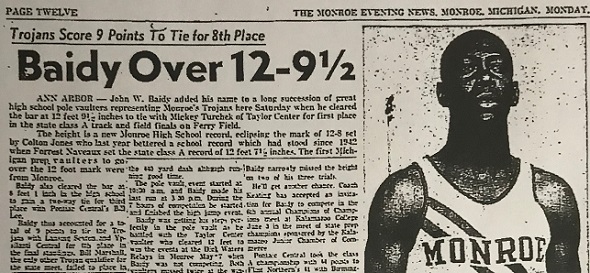
‘Baidy’ not ‘Baldy, ‘John’, not ‘Joe’
“ANN ARBOR - John W. Baidy added his name to a long succession of great high school pole vaulters representing Monroe’s Trojans here Saturday,” stated the Evening News, “when he cleared the bar at 12 feet 9 ½ inches to tie with Mickey Turcheck of Taylor Center for first place in the state Class A track and field finals on Ferry Field …”
“Baidy also cleared the bar at 6 feet 1 inch in the high (jump) to gain a two-way tie for third place with Pontiac Central’s Bill Lee. Baidy thus accounted for a total of 9 points to tie the Trojans with Lansing Sexton and Ypsilanti Central for 8th place in the final standings.”
While there is no mention of the flip for the metal, the article backs up Turcheck’s recall of the day.
Recognizing that despite their best efforts, Moyes and Hollobaugh know that errors can appear in the publication. In their “Notes to the reader” section, they ask readers to please make contact if any mistakes are spotted.
“Thanks to today's modern technology Jeff Hollobaugh will be able to make the appropriate corrections in our book” noted Moyes from Florida via email, noting the marvels of the times we live in. “Better yet for Jeff & I,” added Moyes, displaying his comedic style, “with the amended corrections maybe Mickey Turcheck will purchase our newly revised book.”
Search for Baidy
“They wanted to flip a coin,” said Baidy recently, surprised in the sudden interest in a day from so many years ago and chuckling at the memory. “He got the call and got the medal. I really don’t remember if they told me if I was supposed to get a medal (in the mail). Right after that I had to go to the high jump or something.”
Baidy – who also tied for the Class A Finals high jump championship in 1959 – had received a call earlier on this day from his long-ago opponent from Taylor Center.
“I would certainly like to meet him again,” said Turcheck. His former high school sweetheart and bride had used her smartphone to seek out Baidy’s contact information, and soon after, the two old athletes were reminiscing about the day. Turcheck pitched the idea of getting together for lunch or dinner sometime soon.
“That’s what he wants to do, and it’s all right with me,” Baidy said, noting plans after things settle down. “We’re lucky to still be alive.”
 Ron Pesch has taken an active role in researching the history of MHSAA events since 1985 and began writing for MHSAA Finals programs in 1986, adding additional features and "flashbacks" in 1992. He inherited the title of MHSAA historian from the late Dick Kishpaugh following the 1993-94 school year, and resides in Muskegon. Contact him at [email protected]:void(0);t with ideas for historical articles.
Ron Pesch has taken an active role in researching the history of MHSAA events since 1985 and began writing for MHSAA Finals programs in 1986, adding additional features and "flashbacks" in 1992. He inherited the title of MHSAA historian from the late Dick Kishpaugh following the 1993-94 school year, and resides in Muskegon. Contact him at [email protected]:void(0);t with ideas for historical articles.
PHOTOS: (Top) The 1960 Finals championship medal, front and back, awarded to Baidy. (2) The Fleet Feet of Spring has been revised based on the latest re-discovery of a co-championship. (3) Mickey Turchek went on to compete at Western Michigan. (4) The Monroe Evening News announced John Baidy’s championship pole vault as part of its coverage of the 1960 Class A Track & Field Finals. (Turchek photo courtesy of the Turcheck famly; newspaper clipping courtesy of the Monroe Evening News.)

